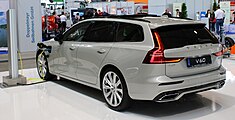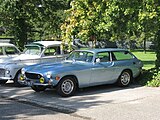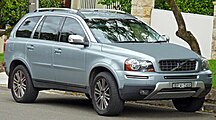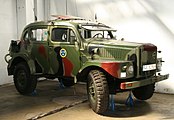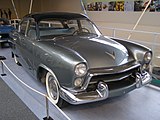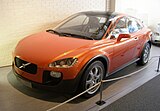Volvo Car Corporation
| Volvo Car Corporation
|
|
|---|---|
| legal form | Aktiebolag |
| founding | 1927 |
| Seat |
Torslanda , Gothenburg, Sweden |
| management | Håkan Samuelsson , CEO |
| Number of employees | 38,000 |
| sales | SEK 252.7 billion |
| Branch | Automotive industry |
| Website | www.volvocars.com |
| Status: December 2018 | |
The Volvo Car Corporation is a Swedish car manufacturer and part of the Volvo Car Group. The company's headquarters are in Gothenburg (Sweden). The Volvo Car Group was originally a core business of the Swedish company, Swedish Volvo Group, but was sold to Ford Motor Company in 1999 . The car manufacturer and its former parent company have been working completely separately since then. In March 2010, Volvo Cars was taken over by the Chinese vehicle group Geely (Zhejiang Geely Holding Group Co. Ltd.).
On July 15, 2010, Li Shufu , owner and chairman of Geely, was appointed chairman of the board of directors of the Volvo Car Group. Håkan Samuelsson has been President and CEO of the Volvo Car Group since October 2012 .
history
The roots of the Volvo Car Corporation lie in the Swedish company Svenska Kullagerfabriken Aktiebolag (SKF). In 1915, SKF patented the “Volvo Ball Bearing” and the brand was born. Volvo Personenvagnar (Volvo Cars) was founded in 1924 as a subsidiary of SKF by the two then SKF employees Assar Gabrielsson and Gustaf Larson . Assar Gabrielson was sales manager and Gustaf Larsson was an engineer. Together they planned a Swedish automobile production. In the autumn of 1924, construction work began on the first vehicle and in 1926 the first ten test vehicles were produced.
SKF appointed Assar Gabrielsson as General Manager from January 1, 1927. SKF quickly invested 200,000 kroner in start-up capital for the planned series production. Gabrielsson shot a further 150,000 crowns from his private fortune.
On April 14, 1927, the first series production Volvo, the Volvo ÖV4 "Jakob", left the factory in Lundby on the Hisingen peninsula near Gothenburg. This appointment, however, stood on shaky legs until the end, because a few hours earlier the car only drove backwards during a test drive. A component that had arrived from Stockholm late at night was installed incorrectly. However, the error could be fixed by the photo session. The ÖV4 (Öppen Vagn = open car) was, according to its name, a four-cylinder open car. In the summer of 1927, the Volvo PV4 (Person Vagn), a four-cylinder closed passenger car, followed. Between 1927 and 1929, 996 vehicles of these two types were sold in different versions.
By 1958, Volvo had launched another ten different vehicle series. The sales figures never exceeded 6,200 vehicles sold per year. In 1954 the rarest of all Volvos appeared, the P1900 with a GRP body, built in only 67 units . The twelfth vehicle series brought the international breakthrough. The Volvo PV444 (1947–1958), known in Germany as “ Buckelvolvo ”, and its successor, the Volvo PV544 (1958–1965), became a global success with 439,995 vehicles sold. The PV544 was equipped with three-point belts as standard in 1959 , and from then on all other Volvo models.
Volvo also had a wide range of military vehicles. Here are e.g. B. the "Radiotransportterrängbil" short Volvo TP21 or "Sugga" (sow) (Bj. 1953–1957, 740 pieces) and Valp (puppy) should be mentioned. The TP 21 was a pure radio vehicle, four-door, all-wheel drive and 100% locks. The Valp had various body shapes, convertible, closed and pick-up.
The next vehicle series was the Volvo P120 series (also known as “Amazon”), of which a total of 667,322 vehicles were built between autumn 1956 and summer 1970. In this vehicle debuted headrests as standard equipment. Volvo thus consolidated its image as a manufacturer of particularly safe cars, with the relatively high market share in the USA always being of particular importance.
From autumn 1961 to the end of 1973, the Volvo P1800 series rolled off the assembly line - an atypical sports car for Volvo. The Volvo P1800 designed by Pelle Petterson became famous through the first season of the television series " Simon Templar " with Roger Moore . The Volvo P1800 was built from autumn 1961 to spring 1972 in various engine variants from 90 to 124 hp, with the first 6,000 copies being assembled by Jensen in England. A P1800S holds the kilometer record for cars with over 2.6 million miles (4.2 million kilometers - as of October 2007). The P1800 ES sports suit, which was manufactured in just 8,077 units from the summer of 1971 to the end of 1973 , became the model for today's lifestyle station wagons and a legend under the nickname “Snow White's Coffin”.
Between 1974 and 1980 the Volvo C303 Cross Country (called Lapplander) was built. It is an all-terrain vehicle that was mainly developed for the military. In addition to the usual two-axle version, a three-axle all-wheel drive version was also available. This then had the designation C304 / 306 and had a larger body. Some models are also in civil use.
From the summer of 1966, the Volvo P140 series created the basis for the long, angular, functional Volvo design . From summer 1968 to spring 1975 it was supplemented by the luxury Volvo P164 as a luxury model .
In the summer of 1974, the successor came with the Volvo 240 series , which was produced until mid-1993. As part of this series, the coupé Volvo 262 C , designed by Bertone, was also created between mid-1976 and the beginning of 1982 , which was very simply designed, but has now achieved a certain collector's status due to its rarity.

In 1975, Volvo acquired the passenger car division of the Dutch company DAF . The vehicle series DAF 46 , which was already on the market , was discontinued, the DAF 66 was further manufactured and sold in a modified form as the Volvo 66 . These DAF and Volvo cars were equipped with the Variomatic gearbox.
From autumn 1975 the Volvo 300 series vehicles were produced in the Dutch plant , some of the 340 series were also equipped with Variomatic transmissions.
Based on the Volvo 340, the Volvo 360 with a 2.0-liter engine was offered by Volvo from summer 1982. The 360 rolled off the assembly line until mid-1989, while the 340 continued to be built until summer 1991.
The 300 series was exported to other European countries, Australia and New Zealand, but not to the USA. The 300 series was particularly successful in Great Britain.
In early 1982 the 700 series was introduced, which was even larger than the 240 series. First the Volvo 760 with a six-cylinder engine came onto the market, which was followed in the spring of 1984 by the Volvo 740 with four-cylinder engines. Based on the 760, there was again a coupé, which was presented in the summer of 1985 as the Volvo 780 .
In the spring of 1986, a sporty station wagon coupé , the 480 , came onto the market, the design of which was based on the 1800 ES and, as the company's first front-wheel drive, paved the way for future vehicles. On its basis, two mid-range sedans in the form of the 440 and 460 were released from autumn 1988 , which were deliberately aimed at the younger group of buyers. The 400 series was made in the Netherlands.
In the summer of 1990, the 700 series was replaced by the Volvo 940 and 960 models . Since many body parts of the 700 series are made of galvanized sheet steel, they enjoy an extremely long service life, which is only underlined by the motors used. Mileage of 600,000 km and more is not uncommon for these vehicles, especially in Sweden.
On January 28, 1999, Volvo and Ford reached an agreement to purchase Volvo Car Corporation for the equivalent of $ 6.45 billion. Volvo is also affected by the financial crisis and received a guarantee from the Swedish government for five billion kroner (445 million euros). With this protection, the company should be given a loan from the European Investment Bank .
On March 28, 2010, Li Shufu , founder and main owner of the Zhejiang Geely Holding Group, and Ford CFO Lewis Booth signed a purchase agreement for the Volvo plant in Gothenburg. Geely took over the Volvo Car Corporation for 1.3 billion euros.
Volvo has been using the Connected Vehicle Cloud cloud service developed by Ericsson since 2012 to provide Internet services in the car. It was also announced that it would offer self-driving cars . The Volvo Car Group will start a project for autonomous driving on public roads from the end of 2013. 100 self-driving vehicles are used in and around Gothenburg. The Drive Me project is supported by the Swedish government. It is part of the Scalable Product Architecture (SPA), which aims to continuously introduce new assistance and safety systems. The first Volvo model based on the new architecture will be the new Volvo XC90, which was presented in 2014.
Sales, number of employees and vehicles sold by Volvo Car Corporation worldwide:
| 2018 | 2017 | 2016 | 2015 | 2014 | 2013 | 2012 | 2011 | 2010 | |
|---|---|---|---|---|---|---|---|---|---|
| Sales (in billions of euros) | 21.5 | 21.1 | 19.1 | 17.3 | 14.5 | 12.9 | 14.5 | 14.1 | 13.3 |
| Employee | 43,500 | 39,500 | 30,374 | 28,119 | 24,124 | 23,200 | 22,715 | 21,512 | 19,494 |
| units sold (pieces) | 642.253 | 571,577 | 534.332 | 503.127 | 465.866 | 427.840 | 421,951 | 449.225 | 373.525 |
Locations worldwide
Volvo Car Corporation has manufacturing facilities in several countries.
- Sweden
- Gothenburg: Headquarter, R&D Center, Design Center
- Torslanda: Vehicle production (Volvo XC90, V90, V90 Cross Country, XC60, V60, V60 Cross Country and future models based on SPA)
- Skövde: engine production
- Olofström: body production
- Belgium / Gent: vehicle production (Volvo V60, V40, V40 Cross Country, XC40 and future models based on CMA)
- Denmark / Copenhagen: R&D Center (branch office)
- China
- Shanghai: Volvo Cars China headquarters, R&D center
- Chengdu: Vehicle production (Volvo XC60)
- Daqing: Vehicle production (Volvo S90, S90L and future models based on SPA)
- Lugiao: Vehicle production (new Volvo 40 models based on CMA, plant together with Geely / Lynk & Co)
- Zhangjiakou: engine production
- Malaysia / Kuala Lumpur: assembly factory
- India / Bangalore: Assembly factory (production takes place in cooperation with the Volvo Group, the Swedish manufacturer of trucks, buses and construction machinery)
- United States
- Sunnyvale / Camarillo: Volvo Car Technology USA / VCTECH California
- Charleston: Vehicle production (Volvo S60, next generation Volvo XC90 from 2021)
Sustainability initiative
Efforts to operate sustainably have long been part of the manufacturer's company philosophy and marketing strategy . Volvo is one of the private-sector founding members of the UN Global Impacts from 1999, which is devoted to ten principles, in addition to obligations to social standards, the development of environmentally friendly technology and initiatives to raise awareness about them.
Every year the group publishes a sustainability report that documents the progress made towards its long-term goals.
Volvo Recharge
As a consequence of the Dieselgate affair, Volvo announced a long-term strategy for the mobility transition. Although the group had not installed any illegal software in its vehicles, measurements by British authorities came to the conclusion that the emissions values of the diesel-powered SUVs XC60 and XC90 exceeded the norm.
With a view to future tightening of the EU's limit values, which stipulate fleet values of 95 g CO 2 / km, Volvo's CEO Hakan Samuelsson announced that he would no longer want to develop another generation of diesel engines and only offer electrified models from 2019 onwards Model XC40 will be the manufacturer's first vehicle to be available purely electrically As part of this, the free delivery and installation of a wallbox is planned and Volvo will cover the energy costs for the first year for unlimited kilometers.
In addition, electrification is being promoted through the redesigned subsidiary brand Polestar .
The engine plant in Skövde, Sweden, has been working climate-neutrally since January 2019, and the same should apply to all production sites for 2025. Five purely electric cars are expected to be available for purchase by 2021 and one million electric vehicles will have been sold by 2025. In addition, the company's own emissions are to be reduced by 40% by the same year. Final climate neutrality is to be achieved by 2040. According to the company's own statements, up to 85% of the vehicles produced are already made from recyclable materials.
A key factor in reducing emissions in the Volvo models is consistent downsizing ; the range now only consists of differently modified four-cylinder engines with turbochargers and direct injection . The effects of downsizing, however, remain controversial, since exhaust gas aftertreatment (especially with diesel units) is more complex in many cases.
In support of the United Nations' environmental campaign for clean seas, Volvo has announced that it will ban all single-use plastic parts from offices, canteens and events and replace them with sustainable materials. In this context, 25% of all plastics used in vehicles should come from recycling cycles. A foretaste of this goal is a special construction of an XC60 T8 plug-in hybrid, in which 170 parts are made of recycled plastic.
In order to increase the transparency of its ecological efforts, Volvo is now using blockchain technology. In this way, manufacturers, dealers and customers can understand the environmental and ethical circumstances under which the cobalt was extracted for the batteries used. An expansion of this initiative is planned.
Contemporary car models
All current Volvo models have a designation consisting of one or two letters and a two-digit number. The letters stand for the body variant (S: notchback sedan (Sedan), V: station wagon (Versatile), XC: off-road model (Cross Country), C: convertible / coupé). The number indicates which class it belongs to.
The mid-range model Volvo 850 , which was offered from autumn 1991, was a great success , which was mainly due to the station wagon version introduced at the beginning of 1993. After a facelift in autumn 1996, which involved a change of name to Volvo V70 (station wagon) and Volvo S70 (sedan), the vehicle was replaced by the Volvo S60 and the Volvo V70 in spring 2000 . In addition, the series has been expanded to include the off-road version Volvo XC70 .
A gap arose below the 850 / V70 after the 440/460 ran out, which was filled by the Volvo S40 / V40 models from the end of 1995 . Because Volvo did not have enough resources to fully develop a new series, a joint venture with Mitsubishi was established . Therefore, the S40 and V40 shared the platform with the Mitsubishi Carisma introduced in autumn 1995 .
In spring 2004 the successor came on the market. The sedan was still called the Volvo S40 , while the station wagon was now called the V50 . This series, which was expanded to include the new Volvo C70 convertible in May 2006 , shares the platform with the Ford Focus . The compact C30 , of which a design study was first shown, is also derived from this platform . The production vehicle was presented in autumn 2006.
The larger 940/960 series was powered by four- and six-cylinder petrol engines and six-cylinder diesel engines. The 960 with a three-liter engine was Volvo's top model. At the end of 1996, the 960 was renamed the S90 (sedan) and V90 (station wagon) or respectively.
In the summer of 1998, the Volvo S80 , which was only built as a sedan, replaced the 900 series. In the summer of 2006, it was launched on the German market in a modified form with a new 3.2-liter six-cylinder and, for the first time, a V8 engine.
In the spring of 1997, a coupé called the Volvo C70 was added to the range. From autumn 1999 it was also built as a convertible and powered by the same engines as the V70 series. Production of the coupé was stopped in autumn 2002, and the much more successful convertible was built until autumn 2005. The successor, which is only available as a convertible, has been in dealerships since May 2006. Unlike its predecessor, it presents itself as a convertible with a steel folding roof , making it a convertible and a coupé in one. The engines range from 140 to 220 hp. In autumn 2006 a diesel engine variant followed, which received the D5 engine known from the S60 / V70, which developed 185 hp.
Since autumn 2002, Volvo has also had the large SUV XC90 in its range, which was also offered with a V8 engine between autumn 2004 and the end of 2010 . This engine, which was developed in cooperation with Yamaha , was the first V8 in the history of Volvo cars, which subsequently found its way into other series. The angle of 60 ° between the cylinder banks, which is unusual for a V8 engine, is worth mentioning. The off-road vehicle range has been supplemented since October 2008 by the compact SUV XC60 , which shares a platform with the V70 / XC70, S80 and Ford Mondeo and is equipped as standard with so-called City Safety technology, which is intended to prevent rear-end collisions at low speeds .
In 2008 the new Powershift transmission from Getrag followed for some Volvo models . It is a direct shift transmission , as it can be found in the VW Golf DSG and since the end of 2007 in the Ford Focus II. In addition, in mid-2008 all models were given a much larger lettering on the rear. From mid-2009, the logo on the front was also enlarged. In the case of the S40 / V50 series, this revision was only carried out in mid-2010.
In September 2010, the second generation of the S60 came on the market. The station wagon version V60 followed two months later .
In March 2012, the new V40 was presented as the successor to the S40 / V50 at the Geneva Motor Show , which went on sale in late summer 2012.
Vehicles currently produced
Car model overview
Timeline
| Timeline of Volvo and DAF models since 1946 | |||||||||||||||||||||||||||||||||||||||||||||||||||||||||||||||||||||||||||
|---|---|---|---|---|---|---|---|---|---|---|---|---|---|---|---|---|---|---|---|---|---|---|---|---|---|---|---|---|---|---|---|---|---|---|---|---|---|---|---|---|---|---|---|---|---|---|---|---|---|---|---|---|---|---|---|---|---|---|---|---|---|---|---|---|---|---|---|---|---|---|---|---|---|---|---|
| Type | Volvo, independent until 1999 | ford | Geely | ||||||||||||||||||||||||||||||||||||||||||||||||||||||||||||||||||||||||
| DAF, sold to Volvo in 1975 | |||||||||||||||||||||||||||||||||||||||||||||||||||||||||||||||||||||||||||
| 1940s | 1950s | 1960s | 1970s | 1980s | 1990s | 2000s | 2010s | 2020s | |||||||||||||||||||||||||||||||||||||||||||||||||||||||||||||||||||
| 6th | 7th | 8th | 9 | 0 | 1 | 2 | 3 | 4th | 5 | 6th | 7th | 8th | 9 | 0 | 1 | 2 | 3 | 4th | 5 | 6th | 7th | 8th | 9 | 0 | 1 | 2 | 3 | 4th | 5 | 6th | 7th | 8th | 9 | 0 | 1 | 2 | 3 | 4th | 5 | 6th | 7th | 8th | 9 | 0 | 1 | 2 | 3 | 4th | 5 | 6th | 7th | 8th | 9 | 0 | 1 | 2 | 3 | 4th | 5 | 6th | 7th | 8th | 9 | 0 | 1 | 2 | 3 | 4th | 5 | 6th | 7th | 8th | 9 | 0 | |
| Small car | 600 / 750 / 30 [1] | 31 [1] | 32 [1] | 33 | |||||||||||||||||||||||||||||||||||||||||||||||||||||||||||||||||||||||
| 44 | 46 | ||||||||||||||||||||||||||||||||||||||||||||||||||||||||||||||||||||||||||
| Compact class | 55 | 66 | 66 | 360 | |||||||||||||||||||||||||||||||||||||||||||||||||||||||||||||||||||||||
| 77 | 340 | ||||||||||||||||||||||||||||||||||||||||||||||||||||||||||||||||||||||||||
| 480 | C30 (P14) | ||||||||||||||||||||||||||||||||||||||||||||||||||||||||||||||||||||||||||
| 440 / 460 | S40 / V40 | S40 / V50 (P11 / P12) | V40 (P1X) | ||||||||||||||||||||||||||||||||||||||||||||||||||||||||||||||||||||||||
| Middle class | PV444 [2] | PV544 [2] | 140 | 240 | |||||||||||||||||||||||||||||||||||||||||||||||||||||||||||||||||||||||
| 120/130/220 ("Amazon") | 850 | S70 (L) | S60 (P24) | S60 (Y20) | Volvo S60 (SPA) | ||||||||||||||||||||||||||||||||||||||||||||||||||||||||||||||||||||||
| PV445 / P210 ("Duet") | V70 (XC) (L) | V70 / XC70 (S / P26) | V60 (Y20) | Volvo V60 (SPA) | |||||||||||||||||||||||||||||||||||||||||||||||||||||||||||||||||||||||
| upper middle class | PV800 | 740 | 940 | V70 / XC70 (P24) |
S90 / V90 (SPA) |
||||||||||||||||||||||||||||||||||||||||||||||||||||||||||||||||||||||
| PV60 | 164 | 260 | 760 | 960 / S90 / V90 | S80 (TS / P23) | S80 (AS / Y20) | |||||||||||||||||||||||||||||||||||||||||||||||||||||||||||||||||||||
| Coupé / Cabriolet | P1900 | P1800 | 262 C | 780 | C70 | C70 II (P15) | |||||||||||||||||||||||||||||||||||||||||||||||||||||||||||||||||||||
| P1800ES [3] | |||||||||||||||||||||||||||||||||||||||||||||||||||||||||||||||||||||||||||
| SUV | XC40 (CMA) | ||||||||||||||||||||||||||||||||||||||||||||||||||||||||||||||||||||||||||
| XC60 (Y20) | XC60 (SPA) | ||||||||||||||||||||||||||||||||||||||||||||||||||||||||||||||||||||||||||
| XC90 (P28) | XC90 (SPA) | ||||||||||||||||||||||||||||||||||||||||||||||||||||||||||||||||||||||||||
|
[1] also known as "Daffodil" |
|||||||||||||||||||||||||||||||||||||||||||||||||||||||||||||||||||||||||||
Pre-war models
- Volvo ÖV4 ("Jakob")
- Volvo PV4
- Volvo PV650 , Volvo PV651 , Volvo PV652
- Volvo PV653 , Volvo PV654 , Volvo PV655
- Volvo PV657 , Volvo PV658 , Volvo PV659
- Volvo PV36 ("Carioca")
- Volvo PV51 , Volvo PV52
- Volvo PV53 , Volvo PV54 , Volvo PV55 , Volvo PV56 , Volvo PV57
Volvo ÖV4 - first series-produced Volvo, with the Volvo logo in the radiator and Penta over it
Volvo PV4 (1927-1929)
Volvo PV 36 "Carioca" in the factory museum
Volvo PV56 IV (1939)
Post war models
- Volvo PV800 ( TP21 "Sugga" , PV821, PV822, PV823, PV824, PV831, PV832, PV833, PV834)
- Volvo PV60 ("The Yankee Car")
- Volvo PV444 / Volvo PV544 (" Humpback Volvo ")
- Volvo PV445 / P210 ("Duet")
- Volvo P1900
- Volvo P120 4-door (P121, P122 for export), P130 2-door, P220 station wagon ("Amazon")
- Volvo P123GT ("Amazon Sport")
- Volvo P1800
- Volvo P1800 ES ("Snow White's Coffin")
- Volvo 66 (originally developed by DAF )
- Volvo 140 (P142: 2-door, P144: 4-door, P145: station wagon)
- Volvo 164
- Volvo 240 (P242: 2-door, P244: 4-door, P245: station wagon)
- Volvo 260 (P264: 4-door, P265: station wagon)
- Volvo 262 C (Coupé)
- Volvo 340 (P343: 3-door, P344: 4-door, P345: 5-door)
- Volvo 360 (P363: 3-door, P364: 4-door, P365: 5-door); better equipment in the 300 series
- Volvo 440 (five-door hatchback sedan)
- Volvo 460 (four-door notchback sedan)
- Volvo 480
- Volvo 740 (P742: 2-door, P744: 4-door, P745: station wagon)
- Volvo 760 (P764: 4-door, P765: station wagon)
- Volvo 780 (Coupé)
- Volvo 850 (P854: 4-door, P855: station wagon)
- Volvo 940 (P944: 4-door, P945: station wagon)
- Volvo 960 (P964: 4-door, P965: station wagon)
- Volvo C30
- Volvo C70
- Volvo S40 / V40
- Volvo S40 / V50
- Volvo V40
- Volvo S60
- Volvo S70
- Volvo S80
- Volvo S90 / V90
- Volvo V60
- Volvo V70
- Volvo V70 CC
- Volvo XC70
- Volvo XC90
- Volvo YCC
- Volvo XC60
- Volvo XC90 II
- Volvo S90
- Volvo V90
- Volvo V90 CC
- Volvo XC60 II
- Volvo XC40
Volvo Amazon (Model 122)
Volvo P1800 ES - "Snow White's Coffin"
Volvo 240 - best-selling Volvo
Volvo 480 ES - the first Volvo with front-wheel drive
Volvo 940 station wagon - last rear-wheel drive Volvo
Volvo XC90 - a great success, especially in the USA
Volvo C70 - first Volvo convertible with a folding roof
Volvo V40 - a new start in the compact class
Military and all-terrain vehicles - model overview
- Volvo TP21
- Volvo C202 ("Lapplander", former names: L3314, L3315)
- Volvo C303 / 304/306 ("Cross Country")
- Volvo L3304 (anti-tank gun carrier 9031)
Volvo TP21 (1953-1958)
Volvo C202 (1977-1981)
Concept vehicles
- Volvo Venus Bilo (1933)
- Volvo Philip (1952)
- Volvo Margarete Rose (1953)
- Volvo Elisabeth I (1953)
- Volvo GTZ (1969)
- Volvo GTZ 3000 (1970)
- Volvo VESC (1972)
- Volvo 1800 ESC (1972)
- Volvo EC (1977)
- Volvo City Taxi (1977)
- Volvo Tundra (1979)
- Volvo VCC - Volvo Concept Car (1980)
- Volvo LCP2000 (1983)
- Volvo ECC - Environment Concept Car (1992)
- Volvo ACC - Adventure Concept Car (1997)
- Volvo SCC - Safety Concept Car (2001)
- Volvo PCC - Performance Concept Car (2001)
- Volvo PCC2 (2002)
- Volvo ACC2 (2002)
- Volvo VCC - Versatility Concept Car (2003)
- Volvo YCC - Your Concept Car (2004)
- Volvo T6 (2005)
- Volvo 3CC (2005)
- Volvo C30 Design Concept (2006)
- Volvo XC60 Concept (2006)
- Volvo ReCharge Concept (2007)
- Volvo S60 Concept (2008)
- C30 DRIVe Electric (2010)
- Volvo Universe Concept (2011)
- Volvo Concept You (2011)
- Volvo Concept Coupe (2013)
- Volvo Concept Estate (2014)
- Volvo Concept XC Coupe (2014)
- Volvo 40.1 (2016)
- Volvo 40.2 (2016)
- Volvo 360c (2018)
Hybrid and electric cars
Volvo produces hybrid and electric cars under the brand of its subsidiary Polestar .
Trivia
The name "Volvo" is derived from Latin. The first person of the singular present indicative of volvere (to roll) is volvo (I roll).
At the IAA 2007 the "Alcoguard" was presented, an alcohol ignition lock . To start the car, the driver has to blow into a wireless hand-held device that measures the breath alcohol content and reports it to the vehicle electronics, which may refuse to start.
literature
- Christer Olsson, Hans Christiansen: Volvo passenger cars 1927-2000. A parade. Translated from the Swedish by Harald Neuhaus. Motorbuch Verlag, Stuttgart 1999, ISBN 3-613-02028-9
- AJ Jacobs: The New Domestic Automakers in the United States and Canada: History, Impacts, and Prospects. Lexington Books, Lanham 2015, ISBN 9780739188255 , p. 36.
Web links
- auto-motor-und-sport.de from December 9, 2017, report on the 90th birthday of Volvo .
- http://www.volvocars.de , http://www.volvocars.at or http://de.volvocars.ch/ - German-language websites of the car manufacturer Volvo
- Volvo Museum website
Individual evidence
- ↑ Successful sale: Volvo goes Chinese at Spiegel Online , December 23, 2009 (accessed December 23, 2009)
- ↑ Handelsblatt: Volvo finally goes into Chinese , accessed on October 17, 2015
- ↑ "Are you still taxiing or are you already driving?" Article on Spiegel.de
- ↑ Björn Engel: Traffic: The seat belt celebrates its 50th birthday. In: welt.de . January 19, 2009, accessed October 7, 2018 .
- ↑ asa / Reuters / afp / AP / dpa: Takeover: Chinese car manufacturer buys Volvo. In: Focus Online . March 28, 2010, accessed October 14, 2018 .
- ↑ Sweden's government helps Volvo with a guarantee : February 24, 2009
- ↑ Volvo Car Group launches a worldwide unique pilot project for autonomous driving on public roads. In: press releases. December 2, 2013, accessed December 3, 2013 .
- ↑ Sweden: Pilot project for autonomous driving with 100 Volvos. In: Heise online . December 2, 2013, accessed January 3, 2018 .
- ↑ Results Center. Retrieved January 24, 2019 .
- ↑ Volvo Car Group Online Annual Report 2017. Accessed February 18, 2019 .
- ↑ Sustainability | Volvo Car Group. Retrieved January 2, 2020 .
- ↑ Volvo Cars. Accessed January 2, 2020 .
- ↑ a b Volvo: Involved in the diesel scandal? - Dieselgate 2020. Accessed January 2, 2020 .
- ↑ a b c Volvo outlook: Swedish eco-initiative - Volvo relies on less plastic and more electricity. June 28, 2018, accessed January 2, 2020 .
- ↑ From 2019 only with an electric motor , tagesschau.de, September 5, 2017
- ↑ "Speed limit is long overdue". Retrieved January 3, 2020 .
- ↑ Volvo Cars presents the XC40 electric car - including high sustainability goals. Retrieved January 3, 2020 .
- ↑ All-electric SUV from Volvo. Retrieved January 3, 2020 (German).
- ↑ Engine technology | Volvo Cars. Accessed January 2, 2020 .
- ↑ Sustainability | Volvo Car Group. Retrieved January 2, 2020 .
- ↑ Downsizing at Volvo. Accessed January 2, 2020 .
- ↑ heise Autos: Study: Otto engines benefit more from downsizing than diesel engines. Accessed January 2, 2020 .
- ↑ Thomas Imhof: Particle filter: The long unrecognized risk of the economical gasoline engine . November 28, 2013 ( welt.de [accessed January 2, 2020]).
- ↑ a b Volvo Cars aims for 25 per cent recycled plastics in cars from 2025 | Volvo Car Group. Retrieved January 2, 2020 .
- ↑ Volvo Cars & Clean Seas XC60 Demo Car. Accessed January 2, 2020 (German).
- ↑ lektroauto: Volvo begins series production of the Polestar 2 , golem.de from March 24, 2020
Coordinates: 57 ° 43 '19.4 " N , 11 ° 51' 17.9" E







